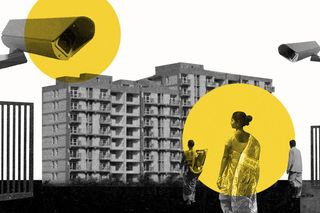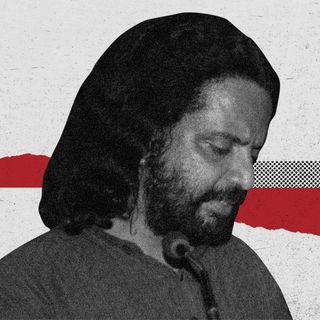
Elite Housing Complexes Are Increasingly Policing, Segregating Domestic Workers Amid the Pandemic
The pandemic could be an opportunity to rethink class divides, but so far it’s only making them wider.

In June, the resident welfare association of the gated complex I live in – in Gurgaon – put up a notice at the entrance to our building, lamenting over the disruptions the pandemic had caused in our daily lives. The notice reiterated the need to isolate, wear a mask, and sanitise. At the end of this rather generic message, the notice said those who wish to have domestic workers resume service would have to download an app, so as to ensure greater safety and accountability during this time. I went back home and followed the directions to download the app, Servizing Society. The app assured me I could restrict “unauthorised” visitors to the society and “tag, monitor and record” all activity of “maids and service providers.”
The day Jashoda Aunty, our cook, was supposed to visit, I noticed a vibrating alert on my phone that informed me of her entry. A screenshot from the surveillance camera attached at the main entrance to the complex was sent to my phone, where I could see Jashoda Aunty’s pixelated face. The app asked me if I recognised her, subject to which she would be allowed to enter. Once I confirmed that I knew her, the app informed me of her movements, up until the time she entered my building. After she left my flat, the app continued to inform me of her whereabouts until her exit from the society. It notified me when she entered another building and another flat, almost as if telling me about all of her social interactions.
The app, while alarming in its flagrant disregard for the privacy and personhood of workers such as Jashoda Aunty, is but a dystopian exaggeration of the technologies of surveillance that already exist to ensure that our upper-middle-class, upper-caste residential complexes remain private silos isolated from those who may be allowed to enter, but remain “unauthorised” visitors. Scholar of urban sociology Aihwa Ong refers to this as the “fortressisation” of urban spaces, a process that begins ostensibly as an “intervention of optimisation” – in this case, to ensure greater safety and accountability in a pandemic – but essentially operates through regulations on movement and surveillance and the creation of boundaries that distinguish the urban elite from the urban poor. In his essay, Castes in India, B.R. Ambedkar remarks that Brahmins achieved and enforced “social detachment” from other castes and communities through a “closed-door policy,” thus designating caste through the spatial organisation of the village. Since the onset of the pandemic, scholars and authors have pointed out how our inherent prejudices about caste and class have become more pronounced in the crisis of Covid19.
Related on The Swaddle:
How the Indian Education System Reinforces Caste, Class Differences
Our society already had varying technologies of segregation and policing that legitimised our suspicion and distrust of service employees. There are smaller segregated elevators for ‘service staff’ beside the larger ones reserved for residents. It is not unusual to notice an indignant resident reprimanding a food delivery executive or an electrician for transgressing these regulations. If any domestic worker enters the premises without visible bags or luggage, but leaves the society with one, they are required to carry a note signed by a resident attesting to the contents of the bag. These measures, which by no means are unique to the complex I live in, encourage a culture of suspicion and distrust of the various individuals and communities whose labour makes our houses liveable. One author calls this the Gurgaon syndrome plaguing Indian urbanity. Symptomatic of the unchecked privatisation of urban infrastructure, the city is marked by a highly segregated urban culture. Urban sociologist Sanjay Srivastava makes Gurgaon the subject of his aptly titled book Entangled Urbanism: Slum, Gated Community, and Shopping Mall in Delhi and Gurgaon. He notes that the increasing visibility of resident welfare associations in the civic politics of the city points to the growing associations of authority and governance with ownership of private property.
This phenomenon is by no means unique to Gurgaon, though. The pandemic shows us how spatial and social segregation between those with homes and those without or away from homes (such as migrants, whose treatment by the state since the pandemic is well known) is deeply rooted in the middle class imagination of security and safety. The lives of those who live in neighbourhoods or colonies identified as ‘illegal’ by the state — who often come to housing societies like mine in search of employment — are constantly perceived as a threat to the order and legality of our dwelling.
The pandemic can and must be an opportunity for us to think more critically about the state of urban poverty and wealth disparity that define our cities. The suffering brought on by the pandemic may feel universal and, in some senses, it even is. But while some of the more privileged of us are trying to now cope and make sense of the ‘new normal,’ for many others, this crisis has been a continuation of their already precarious circumstances. The impulse to keep ourselves and our loved ones safe during the pandemic can be overwhelming. But it would be prudent to ask ourselves: what, or whom, are we really trying to protect our communities from?
Aishwarya Chandran is a Ph.D. candidate at IIT, Delhi. You can follow her at @AishwaryaCee.
Related


Emerging Brain Research Suggests Human Physiology Doesn’t Reflect a Gender Binary
